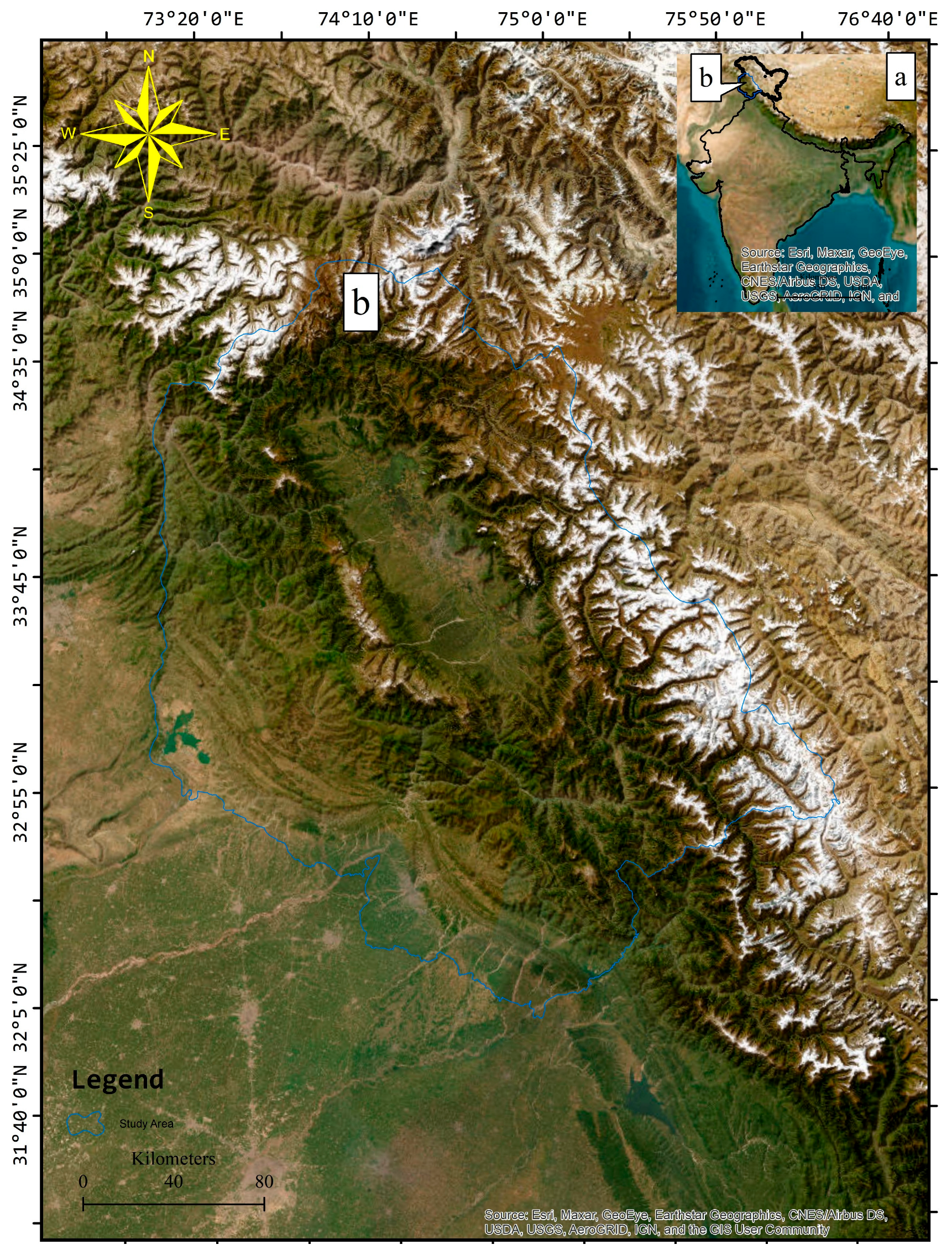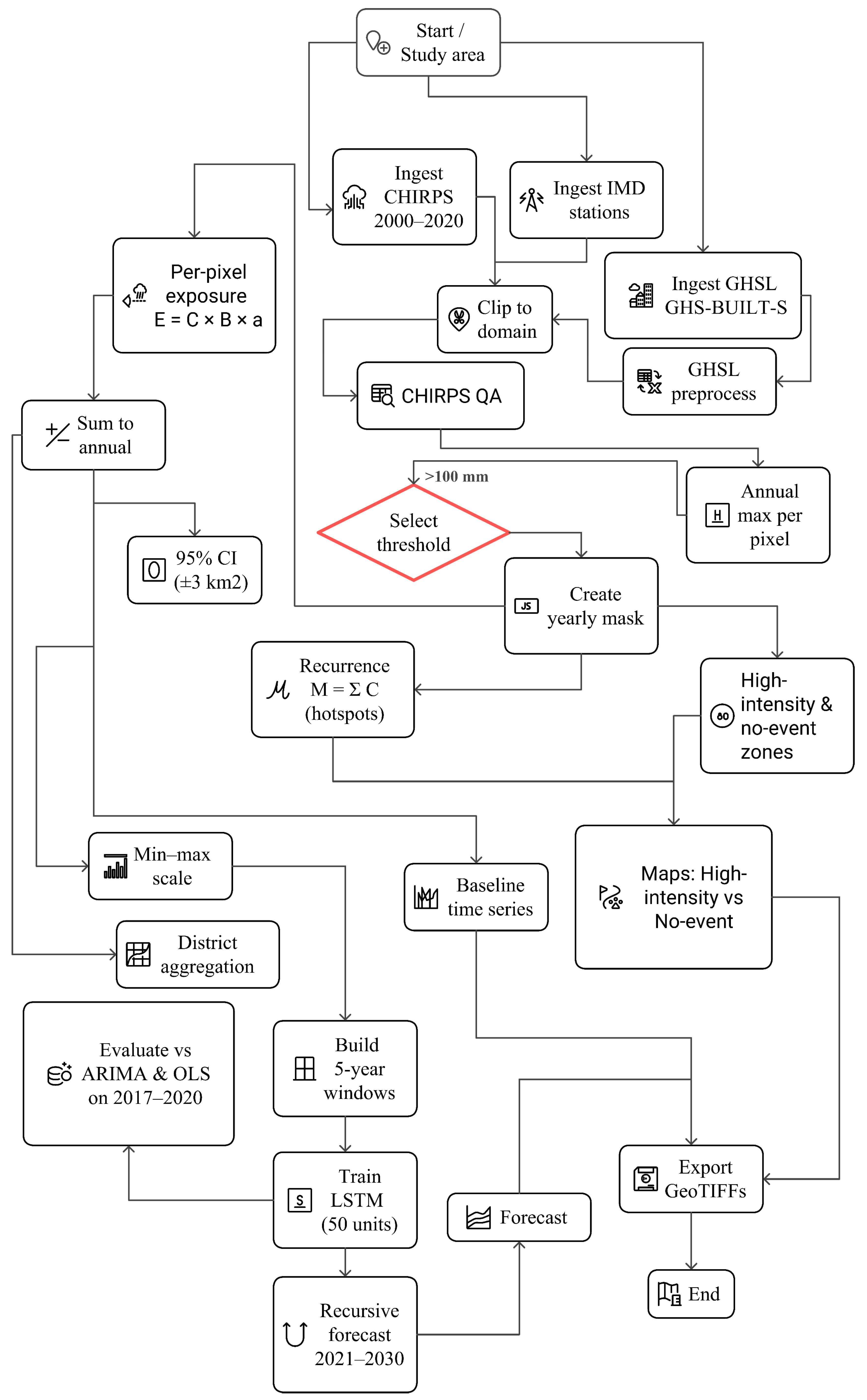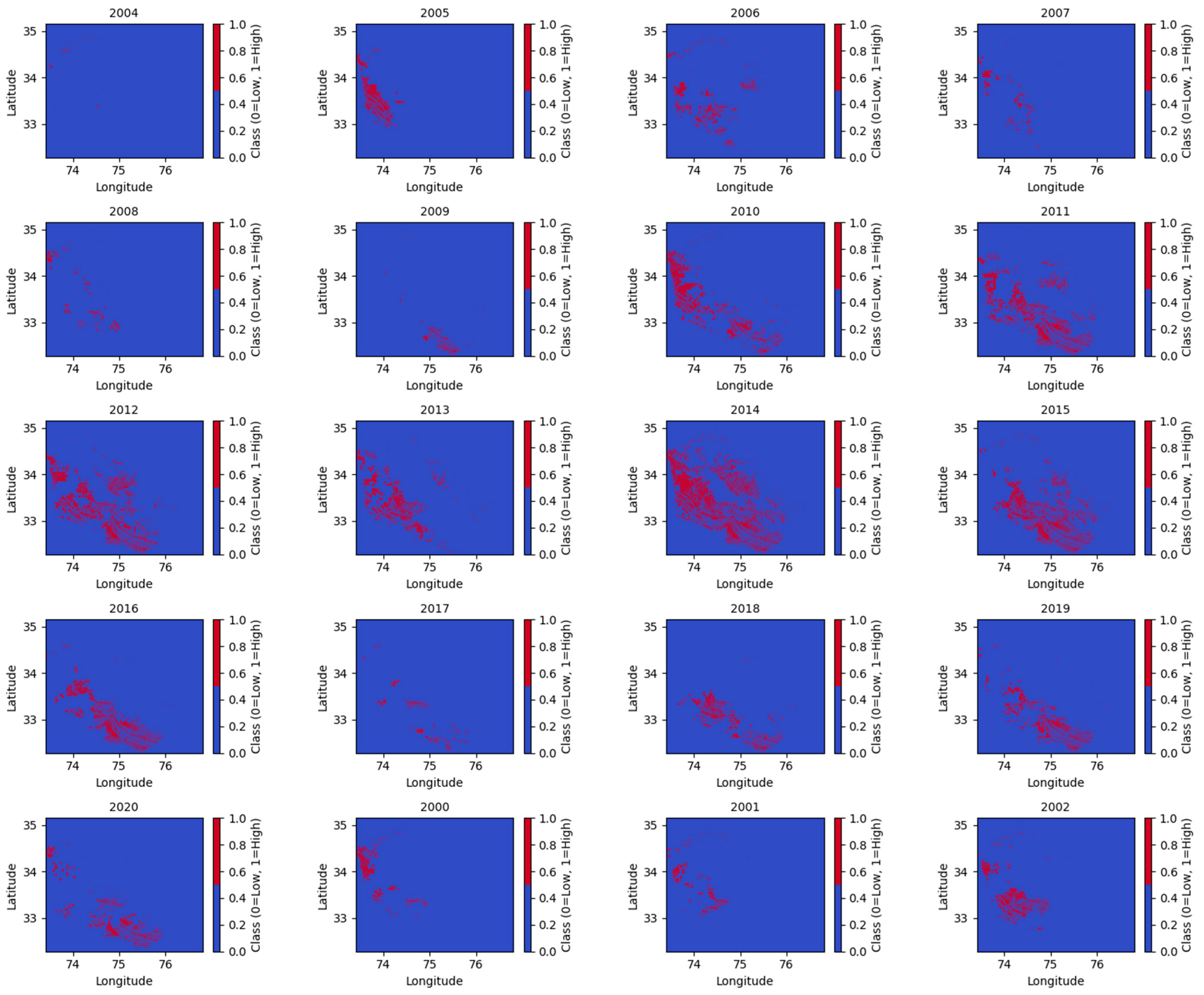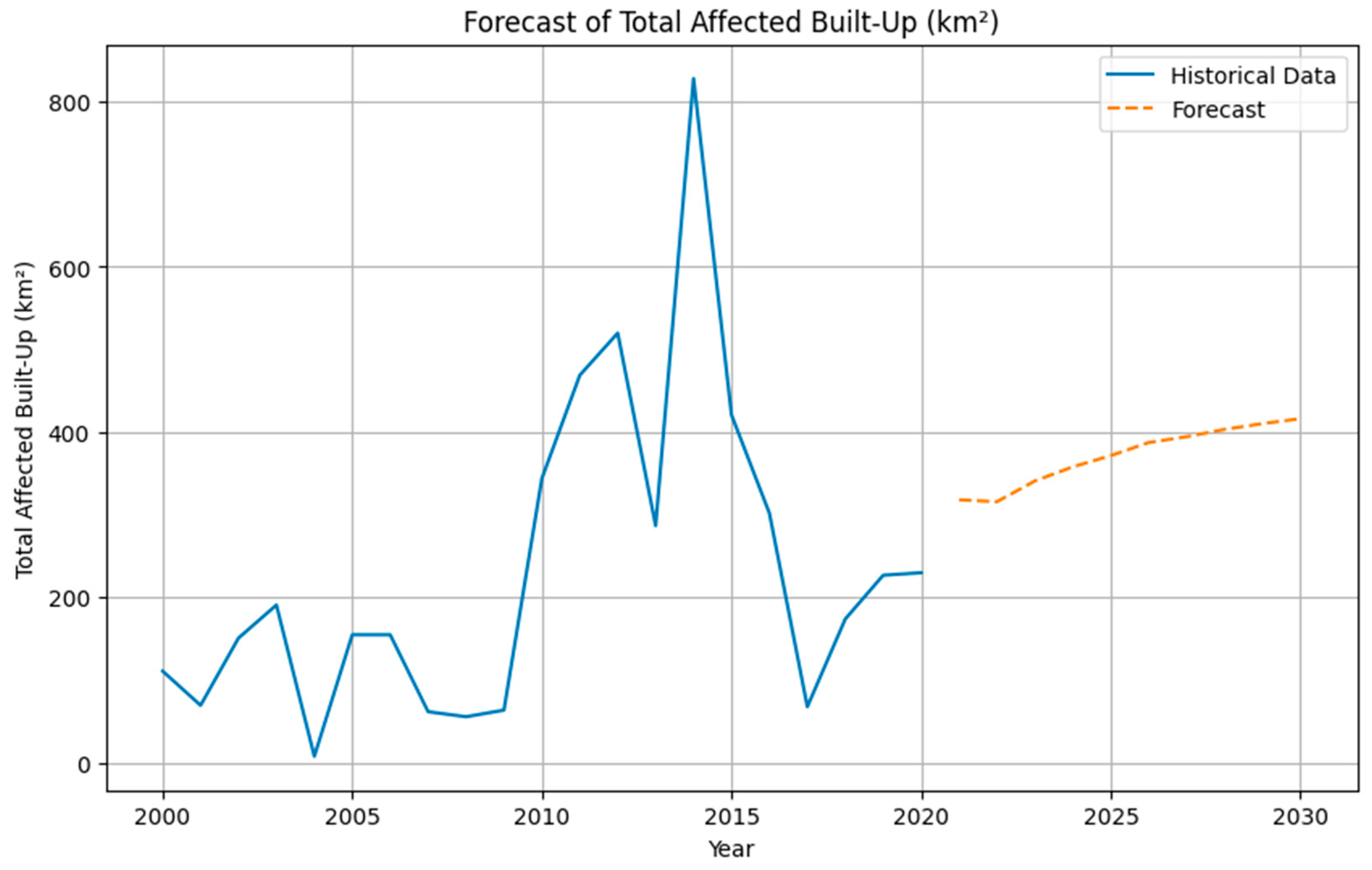Spatiotemporal Exposure to Heavy-Day Rainfall in the Western Himalaya Mapped with Remote Sensing, GIS, and Deep Learning
Abstract
1. Introduction
2. Materials and Methods
2.1. Study Area
2.2. Methodology
2.2.1. Precipitation Input
2.2.2. Definition of Heavy-Day Rainfall (HDR)
2.2.3. Built-Up Surface Layer
2.2.4. Overlay and Exposure Metrics
2.2.5. Time-Series Preparation for Forecasting
2.2.6. LSTM Architecture and Validation
2.2.7. Output Products and Post-Processing
2.2.8. Uncertainty Considerations
2.2.9. Future Forecasting of HDR Exposure
3. Results
3.1. Spatiotemporal Distribution of HDR
3.2. Annual Exposure of Built-Up
3.3. High-Intensity Rainfall Zones
3.4. Predictive Modeling
4. Discussion
5. Conclusions
Author Contributions
Funding
Institutional Review Board Statement
Data Availability Statement
Acknowledgments
Conflicts of Interest
References
- IPCC. 2021: Summary for Policymakers. In Climate Change 2021: The Physical Science Basis. Contribution of Working Group I to the Sixth Assessment Report of the Intergovernmental Panel on Climate Change; Masson-Delmotte, V., Zhai, P., Pirani, A., Connors, S.L., Péan, C., Berger, S., Caud, N., Chen, Y., Goldfarb, L., Gomis, M.I., et al., Eds.; IPCC: Geneva, Switzerland, 2021; Available online: https://www.ipcc.ch/report/ar6/wg1/chapter/summary-for-policymakers/ (accessed on 5 June 2025).
- Nagamani, K.; Mishra, A.K.; Meer, M.S.; Das, J. Understanding flash flooding in the Himalayan Region: A case study. Sci. Rep. 2024, 14, 7060. [Google Scholar] [CrossRef]
- Dar, T.; Aziz, K. Assessment and Management of Flash Floods in the India Himalayas. In Water Resources Management in Mountain Regions; Wiley: Hoboken, NJ, USA, 2025; pp. 301–317. ISBN 9781394249619. [Google Scholar]
- Dimri, A.P.; Niyogi, D.; Barros, A.P.; Ridley, J.; Mohanty, U.C.; Yasunari, T.; Sikka, D.R. Western Disturbances: A review. Rev. Geophys. 2015, 53, 225–246. [Google Scholar] [CrossRef]
- Murata, F.; Terao, T.; Chakravarty, K.; Syiemlieh, H.J.; Cajee, L. Characteristics of Orographic Rain Drop-Size Distribution at Cherrapunji, Northeast India. Atmosphere 2020, 11, 777. [Google Scholar] [CrossRef]
- Bhat, A.A.; Dhondiram, P.D.; Gupta, S.K.; Kanga, S.; Singh, S.K.; Meraj, G.; Kumar, P.; Sajan, B. Snow Resources and Climatic Variability in Jammu and Kashmir, India. Climate 2025, 13, 28. [Google Scholar] [CrossRef]
- Maftei, C.; Muntean, R.; Vaseashta, A. Modeling and Monitoring Extreme Hydrometeorological Events; IGI Global: Hershey, PA, USA, 2024; ISBN 9781668487716. [Google Scholar]
- Hansen, M.C.; Potapov, P.V.; Moore, R.; Hancher, M.; Turubanova, S.A.; Tyukavina, A.; Thau, D.; Stehman, S.V.; Goetz, S.J.; Loveland, T.R.; et al. High-Resolution Global Maps of 21st-Century Forest Cover Change. Science 2013, 342, 850–853. [Google Scholar] [CrossRef]
- Ranjitkar, S.; Kindt, R.; Sujakhu, N.M.; Hart, R.; Guo, W.; Yang, X.; Shrestha, K.K.; Xu, J.; Luedeling, E. Separation of the bioclimatic spaces of Himalayan tree rhododendron species predicted by ensemble suitability models. Glob. Ecol. Conserv. 2014, 1, 2–12. [Google Scholar] [CrossRef]
- Wang, X.; Xie, H. A Review on Applications of Remote Sensing and Geographic Information Systems (GIS) in Water Resources and Flood Risk Management. Water 2018, 10, 608. [Google Scholar] [CrossRef]
- Kranjčić, N.; Medak, D.; Župan, R.; Rezo, M. Support Vector Machine Accuracy Assessment for Extracting Green Urban Areas in Towns. Remote Sens. 2019, 11, 655. [Google Scholar] [CrossRef]
- Zhang, G.; Wang, M.; Liu, K. Forest Fire Susceptibility Modeling Using a Convolutional Neural Network for Yunnan Province of China. Int. J. Disaster Risk Sci. 2019, 10, 386–403. [Google Scholar] [CrossRef]
- Hochreiter, S.; Schmidhuber, J. Long Short-Term Memory. Neural Comput. 1997, 9, 1735–1780. [Google Scholar] [CrossRef]
- Ouma, Y.O.; Cheruyot, R.; Wachera, A.N. Rainfall and runoff time-series trend analysis using LSTM recurrent neural network and wavelet neural network with satellite-based meteorological data: Case study of Nzoia hydrologic basin. Complex Intell. Syst. 2022, 8, 213–236. [Google Scholar] [CrossRef]
- Khosravi, Y.; Ouarda, T.B. Drought risks are projected to increase in the future in central and southern regions of the Middle East. Commun. Earth Environ. 2025, 6, 384. [Google Scholar] [CrossRef]
- Zhu, Z.; Wang, S.; Woodcock, C.E. Improvement and expansion of the Fmask algorithm: Cloud, cloud shadow, and snow detection for Landsats 4–7, 8, and Sentinel 2 images. Remote Sens. Environ. 2015, 159, 269–277. [Google Scholar] [CrossRef]
- Liu, Z.; Yao, Z.; Wang, R. Assessing methods of identifying open water bodies using Landsat 8 OLI imagery. Environ. Earth Sci. 2016, 75, 873. [Google Scholar] [CrossRef]
- Mondal, A.; Khare, D.; Kundu, S. Spatial and temporal analysis of rainfall and temperature trend of India. Theor. Appl. Clim. 2015, 122, 143–158. [Google Scholar] [CrossRef]
- Das, L.; Meher, J.K. Drivers of climate over the Western Himalayan region of India: A review. Earth-Science Rev. 2019, 198, 102935. [Google Scholar] [CrossRef]
- Hekmat, H.; Ahmad, T.; Singh, S.K.; Kanga, S.; Meraj, G.; Kumar, P. Land Use and Land Cover Changes in Kabul, Afghanistan Focusing on the Drivers Impacting Urban Dynamics during Five Decades 1973–2020. Geomatics 2023, 3, 447–464. [Google Scholar] [CrossRef]
- Meraj, G. Assessing the Impacts of Climate Change on Ecosystem Service Provisioning in Kashmir Valley India. Ph.D. Thesis, Suresh Gyan Vihar University, Jaipur, India, 2021. Available online: http://hdl.handle.net/10603/354338 (accessed on 25 April 2025).
- Funk, C.; Peterson, P.; Landsfeld, M.; Pedreros, D.; Verdin, J.; Shukla, S.; Husak, G.; Rowland, J.; Harrison, L.; Hoell, A.; et al. The climate hazards infrared precipitation with stations—A new environmental record for monitoring extremes. Sci. Data 2015, 2, 150066. [Google Scholar] [CrossRef]
- India Meteorological Department. Heavy Rainfall Warning Services: Operational Guidelines and Classification Thresholds (Brochure). Ministry of Earth Sciences, Government of India. 2021. Available online: https://mausam.imd.gov.in/imd_latest/contents/pdf/pubbrochures/Heavy%20Rainfall%20Warning%20Services.pdf (accessed on 5 June 2025).
- Hirata, H.; Fujinami, H.; Kanamori, H.; Sato, Y.; Kato, M.; Kayastha, R.B.; Shrestha, M.L.; Fujita, K. Multiscale processes leading to heavy precipitation in the eastern Nepal Himalayas. J. Hydrometeorol. 2023, 24, 641–658. [Google Scholar] [CrossRef]
- Pokharel, B.; Wang, S.-Y.S.; Meyer, J.; Marahatta, S.; Nepal, B.; Chikamoto, Y.; Gillies, R. The east–west division of changing precipitation in Nepal. Int. J. Climatol. 2019, 40, 3348–3359. [Google Scholar] [CrossRef]
- Melchiorri, M. The global human settlement layer sets a new standard for global urban data reporting with the urban centre database. Front. Environ. Sci. 2022, 1–18. [Google Scholar] [CrossRef]
- Bhatt, C.M.; Rao, G.S.; Farooq, M.; Manjusree, P.; Shukla, A.; Sharma, S.V.S.P.; Kulkarni, S.S.; Begum, A.; Bhanumurthy, V.; Diwakar, P.G.; et al. Satellite-based assessment of the catastrophic Jhelum floods of September 2014, Jammu & Kashmir, India. Geomat. Nat. Hazards Risk 2017, 8, 309–327. [Google Scholar] [CrossRef]
- Zappa, G. Regional Climate Impacts of Future Changes in the Mid–Latitude Atmospheric Circulation: A Storyline View. Curr. Clim. Chang. Rep. 2019, 5, 358–371. [Google Scholar] [CrossRef]
- Pandey, A.; Shekhar Sarkar, M.; Palni, S.; Parashar, D.; Singh, G.; Kaushik, S.; Chandra, N.; Costache, R.; Pratap Singh, A.; Pratap Mishra, A.; et al. Multivariate statistical algorithms for landslide susceptibility assessment in Kailash Sacred landscape, Western Himalaya. Geomat. Nat. Hazards Risk 2023, 14, 2227324. [Google Scholar] [CrossRef]
- Emanuel, K.A. Atmospheric Convection; Oxford University Press: New York, NY, USA, 1994. [Google Scholar]
- Doswell, C.A. Severe Convective Storms—An Overview. Meteorol. Monogr. 2001, 28, 1–26. [Google Scholar] [CrossRef]
- Walsh, C.J.; Roy, A.H.; Feminella, J.W.; Cottingham, P.D.; Groffman, P.M.; Morgan, R.P. The urban stream syndrome: Current knowledge and the search for a cure. J. N. Am. Benthol. Soc. 2005, 24, 706–723. [Google Scholar] [CrossRef]
- Guan, M.; Sillanpää, N.; Koivusalo, H. Storm runoff response to rainfall pattern, magnitude and urbanization in a developing urban catchment. Hydrol. Process 2016, 30, 543–557. [Google Scholar] [CrossRef]
- Smith, R.B. The Influence of Mountains on the Atmosphere. In Advances in Geophysics; Saltzman, B.B.T., Ed.; Elsevier: New York, NY, USA, 1979; Volume 21, pp. 87–230. ISBN 0065-2687. [Google Scholar]
- Houze, R.A., Jr. Cloud Dynamics, 2nd ed.; Academic Press: San Diego, CA, USA, 2014; ISBN 9780123742667. [Google Scholar]
- Bonan, G.B. Forests and Climate Change: Forcings, Feedbacks, and the Climate Benefits of Forests. Science 2008, 320, 1444–1449. [Google Scholar] [CrossRef] [PubMed]
- Nations, U. Sendai Framework for Disaster Risk Reduction 2015–2030; United Nations: Sendai, Japan, 2015. [Google Scholar]
- Ahern, J.; Cilliers, S.; Niemelä, J. The concept of ecosystem services in adaptive urban planning and design: A framework for supporting innovation. Landsc. Urban Plan. 2014, 125, 254–259. [Google Scholar] [CrossRef]
- Feng, Z.; Houze, R.A.; Leung, L.R.; Song, F.; Hardin, J.C.; Wang, J.; Gustafson, W.I.; Homeyer, C.R. Spatiotemporal Characteristics and Large-Scale Environments of Mesoscale Convective Systems East of the Rocky Mountains. J. Clim. 2019, 32, 7303–7328. [Google Scholar] [CrossRef]
- Barik, K.K.; Mishra, V.; Mohanty, J.R.; Debbarma, M.K.; Barik, R.K. Cloud GIS Model for Coastal Geospatial Big Data Analytics. In BT—Data Science in Societal Applications: Concepts and Implications; Rautaray, S.S., Pandey, M., Nguyen, N.G., Eds.; Springer Nature: Singapore, 2022; pp. 1–11. ISBN 978-981-19-5154-1. [Google Scholar]
- Kumar, R.; Bhanu, M.; Mendes-Moreira, J.; Chandra, J. Spatio-Temporal Predictive Modeling Techniques for Different Domains: A Survey. ACM Comput. Surv. 2024, 57, 1–42. [Google Scholar] [CrossRef]
- Sun, Y.; Chen, X.; Wu, J.; Yuan, H.; Shi, H.; Zhan, X.; Zhang, L. Development of a multi-view and geo-event-driven real-time collaborative GIS. Int. J. Digit. Earth 2022, 15, 134–147. [Google Scholar] [CrossRef]
- Kaiser, Z.R.M.A.; Akter, F. From risk to resilience and sustainability: Addressing urban flash floods and waterlogging. Risk Sci. 2025, 1, 100011. [Google Scholar] [CrossRef]
- Glade, T. Landslide occurrence as a response to land use change: A review of evidence from New Zealand. CATENA 2003, 51, 297–314. [Google Scholar] [CrossRef]
- Zhou, L.; Liu, L. Enhancing dynamic flood risk assessment and zoning using a coupled hydrological-hydrodynamic model and spatiotemporal information weighting method. J. Environ. Manag. 2024, 366, 121831. [Google Scholar] [CrossRef]
- Bhat, A.A.; Gupta, S.K.; Singh, S.K.; Meraj, G.; Kumar, P.; Kanga, S.; Singh, S.; Sajan, B. Simulating Climatic Patterns and Their Impacts on the Food Security Stability System in Jammu, Kashmir and Adjoining Regions, India. Climate 2024, 12, 99. [Google Scholar] [CrossRef]
- Cutter, S.L.; Boruff, B.J.; Shirley, W.L. Social Vulnerability to Environmental Hazards. Soc. Sci. Q. 2003, 84, 242–261. [Google Scholar] [CrossRef]







| Threshold (mm/Day) | Affected Built-Up Area (km2, 2000–2020) | High-Intensity Zone Area (km2) |
|---|---|---|
| 80 | 8140.76 | 48,280.50 |
| 100 | 4894.092 | 31,555.26 |
| 120 | 2990.12 | 15,777.63 |
| Exposure Class | Area (km2) |
|---|---|
| High-intensity zone (≥1 event) | 31,555.26 |
| No-event zone (0 events) | 37,897.04 |
| Model | RMSE (km2) | MAE (km2) | R2 |
|---|---|---|---|
| LSTM | 0.82 | 0.65 | 0.89 |
| ARIMA | 1.10 | 0.90 | 0.75 |
| Linear Regression | 1.25 | 1.05 | 0.70 |
Disclaimer/Publisher’s Note: The statements, opinions and data contained in all publications are solely those of the individual author(s) and contributor(s) and not of MDPI and/or the editor(s). MDPI and/or the editor(s) disclaim responsibility for any injury to people or property resulting from any ideas, methods, instructions or products referred to in the content. |
© 2025 by the authors. Licensee MDPI, Basel, Switzerland. This article is an open access article distributed under the terms and conditions of the Creative Commons Attribution (CC BY) license (https://creativecommons.org/licenses/by/4.0/).
Share and Cite
Dar, Z.A.; Gupta, S.K.; Kanga, S.; Singh, S.K.; Meraj, G.; Kumar, P.; Sajan, B.; Đurin, B.; Kranjčić, N.; Dogančić, D. Spatiotemporal Exposure to Heavy-Day Rainfall in the Western Himalaya Mapped with Remote Sensing, GIS, and Deep Learning. Geomatics 2025, 5, 37. https://doi.org/10.3390/geomatics5030037
Dar ZA, Gupta SK, Kanga S, Singh SK, Meraj G, Kumar P, Sajan B, Đurin B, Kranjčić N, Dogančić D. Spatiotemporal Exposure to Heavy-Day Rainfall in the Western Himalaya Mapped with Remote Sensing, GIS, and Deep Learning. Geomatics. 2025; 5(3):37. https://doi.org/10.3390/geomatics5030037
Chicago/Turabian StyleDar, Zahid Ahmad, Saurabh Kumar Gupta, Shruti Kanga, Suraj Kumar Singh, Gowhar Meraj, Pankaj Kumar, Bhartendu Sajan, Bojan Đurin, Nikola Kranjčić, and Dragana Dogančić. 2025. "Spatiotemporal Exposure to Heavy-Day Rainfall in the Western Himalaya Mapped with Remote Sensing, GIS, and Deep Learning" Geomatics 5, no. 3: 37. https://doi.org/10.3390/geomatics5030037
APA StyleDar, Z. A., Gupta, S. K., Kanga, S., Singh, S. K., Meraj, G., Kumar, P., Sajan, B., Đurin, B., Kranjčić, N., & Dogančić, D. (2025). Spatiotemporal Exposure to Heavy-Day Rainfall in the Western Himalaya Mapped with Remote Sensing, GIS, and Deep Learning. Geomatics, 5(3), 37. https://doi.org/10.3390/geomatics5030037














